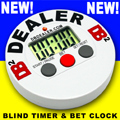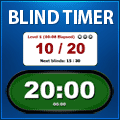|
|
Poker Tournament RulesThese HomePokerTourney No-limit Texas Hold'em poker tournament rules are to be used in conjunction with ‘Robert’s Rules of Poker’. Where there is a discrepancy between these rules and Robert’s Rules of Poker, these rules shall take precedence. Buyin/Rebuy/Add-onThe dollar amount of the initial buyin shall be posted in plain view of the playing table(s). The buyin shall purchase 1000 chips. These chips have no monetary value. You may rebuy into the tournament if you have lost all your chips before the first hand of the fourth blinds level is dealt. Rebuys will be in the same dollar amount and chips as the initial buyin. For example, if the initial buyin of $25 purchased 1000 chips, the rebuy will be $25 and will purchase 1000 chips. Each player is allowed only one rebuy per tournament. There are no Add-ons in this tournament. PayoutAll monies paid in will be paid out. The purse is the total of all the buyins, rebuys, and add-ons. The prize structure shall be posted in plain view of the playing table(s). The prize structure will be similar to the following: first prize will be 40% of the purse, second prize will be 25%, third prize will be 20%, fourth prize will be 10% and fifth prize will be 5%. Winning the TournamentThe final player remaining with all the chips will be the first prize winner. The last player eliminated will be the second prize winner; the second last player eliminated will be the third prize winner, etc.. If more than one player is eliminated on the same hand, the player(s) with the highest chip count at the start of the hand will be awarded the highest place(s). Players may 'cut side deals' to split prizes but the Tournament Director is never responsible for the execution of these deals. Late PlayersPlayers who have committed their attendance to the Tournament Director but have not arrived by the deal of the first hand will, at the Tournament Director’s discretion, be assigned a seat, issued chips, and dealt hands. A player will post all appropriate blinds/antes on behalf of the absent player. If the absent player has not arrived before the first hand of the second blind is dealt, the absent player’s chips are removed from play and he forfeits any chance to play. Timer Use and BreaksWhen the blinds timer expires, it shall be immediately restarted. The next hand will be dealt at the new blind level. For the purpose of this rule, a hand is considered currently in play once the all blinds/antes are posted AND the dealer has begun shuffling (riffles the deck). Breaks will be at the discretion of the Tournament Director. The timer is stopped during breaks and during any disputes that occur which require attention from the tournament director to resolve. No additional hands at any table should be started during such a break although hands already in progress should be completed. Blinds ScheduleThe blinds schedule shall be posted in plain view of the playing table(s). A suggested T1000 or T1500 blinds schedule is included with these rules. Seating PlayersEach table will seat a maximum of 10 players. Players will be distributed as evenly as possible between all tables. Prepare a deck of cards consisting of one card for each seat at each table. For example, if you have two tables of 8 players and one table of 9 players, prepare a deck consisting of the A-8 of spades (Table1), the A-8 of hearts (Table2), and the A-9 of clubs (Table3). When the tournament begins, or when a new table or tables are formed, each player draws a single card. The Ace is seated at the button, the 2 is the small blind, the 3 is the big blind, and then each player is seated in proper card order. Card suit is used to determine which table a player is seated at. For example, all spades sit at Table1, all hearts sit at Table2, and all clubs sit at Table3. When three tables are in play, each table will play internally to itself until there are 18 players remaining. These 18 players will be randomly seated, using the same method as above, to form two tables. When two tables are in play, each table will play internally to itself until there are 9 players remaining. These 9 players will be randomly seated, using the same method as above, to form the final table. If you want three dealers to each sit at three different tables, you first divide the cards into three stacks - one stack of spades, one stack of hearts and one stack of clubs. Each dealer then randomly draws one card from a different stack. You then combine all the remaining cards together for the non-dealers to draw from. First seat the dealer in the middle of each table, then seat the other players, in proper card order, around the dealer. Moving PlayersIf the number of players differs by two or more between any two tables, one player must move from the highest populated table to the lowest populated table. When forced to choose between removing a player from more than one equally populated table; one card will be dealt to each table in question and the low card table will move a player (ace of spades is high). When a player is eliminated and a move must be made, the player ‘playing a hand’ in the same position (seat), relative to the button, at the highest populated table must move to the eliminated player’s seat. The move must occur before the next hand is dealt at any table. For the purposes of this rule, a player is ‘playing a hand’ once all the blinds/antes have been posted and the dealer has begun shuffling (riffles the deck). A moved player will be dealt a hand at the start of the next deal and assume any obligation of the new seat including the posting of a blind or dealing. Moving occurs after the conclusion of all hands being played at all tables. If several players must be moved at the same time, begin with the eliminated player, at the lowest populated table, closest to the left of the button.
Dead Button RuleIf the big blind busts out and is not replaced by a player from another table, the button moves to the player who posted the small blind and the player to the left of the former big blind assumes the big blind. There is no small blind for that hand. On the following deal, the button moves to the now empty seat (the seat vacated by the eliminated big blind player) and the two players to the left post the normal blinds. This will result in the same player being the dealer two hands in a row. When the small blind busts out and is not replaced by a player from another table, the button does not move. The player who was the big blind will now post the small blind and the player to his left will post the big blind. This will result in the same player being the dealer two hands in a row. Players LeavingThere will be no refunds or cash-outs given to players who leave the game after the first hand is dealt. If a player leaves the table for any reason and will return before 20 minutes are up, he can opt to drop every hand that occurs during his absence. He will be responsible for all antes and blinds and will be dealt hands. Players remaining at the table, or another person designated by the absentee, will post all antes and blinds for the absent player. If the missing player is moved to another table, his chips will move and he will continue to blind appropriately at the new table. Any player who does not return within 20 minutes forfeits all his remaining chips, to be split evenly among the remaining players at that table. Odd chips are returned to the bank. If a player leaves the table for any reason and will be away for longer than 20 minutes, he forfeits all his remaining chips, to be split evenly among the remaining players at that table. Odd chips are returned to the bank. The Tournament DirectorThe Tournament Director is responsible for all table, seating and dealer decisions. The Tournament Director is responsible for the handling of the timer although may delegate this task to any dealer/player at his discretion. In the case of disputes and rules interpretations, the Tournament Director will have final authority. If the dispute directly involves the Tournament Director, a third-party will be appointed to resolve the dispute. Version 2
Click here to download a Microsoft Word version of these poker tournament rules. |
||||||||||||||||||||||||||||||||||||||||||||||||||||||||||||||||||||||||||||||||||||||||||||||||||||||||||||
Online Poker Guide
Hand Converter
Holdem strategy
Freeroll tournaments
Poker calculator
Online poker
Poker rooms
> poker pokeren
> iDeal poker
> online casino
> iDeal casino
> casino casinos
> casino bonus
Get Bonus code Titan Poker, and full tilt poker referral code or max bonus to the full tilt referral code. Best ultimate bet referral code sign up bonus doyles room promo code or poker host bonus code
























